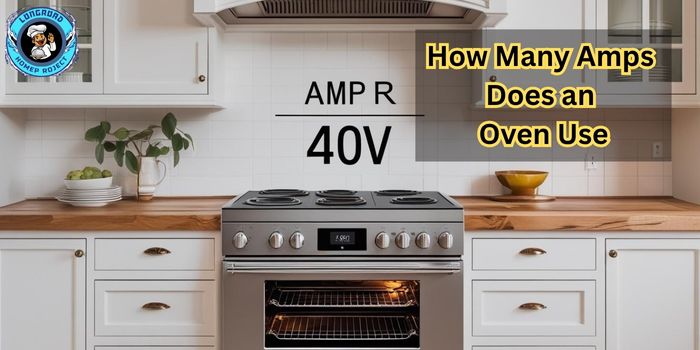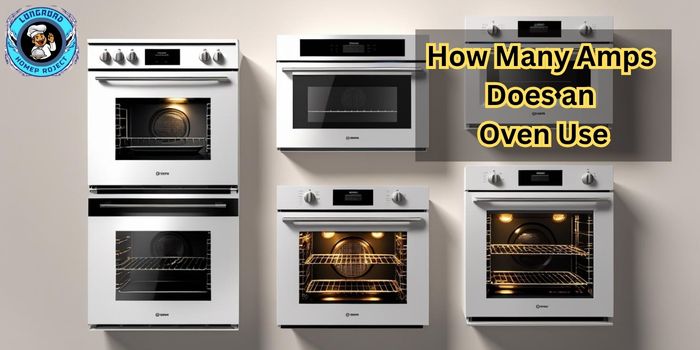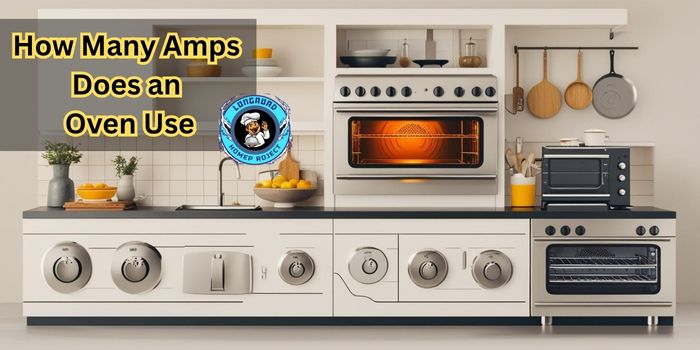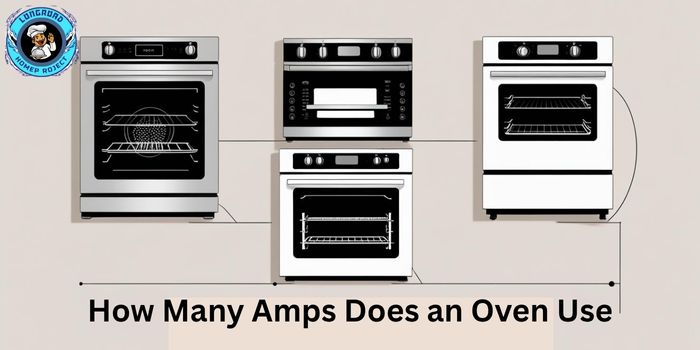As an Amazon Associate I earn from qualifying purchases.
If you’ve ever tripped a breaker while cooking Thanksgiving dinner, you already know how frustrating — and confusing — an oven’s electrical needs can be. Understanding how many amps an oven uses isn’t just a technical curiosity; it’s the difference between a smooth cooking experience and a cold, half-baked turkey. Whether you’re upgrading your kitchen appliances, planning a remodel, or simply curious about your electric bill, knowing an oven’s amperage is a key part of managing power usage safely and efficiently.
In this complete 2025 guide, we’ll break down the essentials of amps, watts, and volts, explain how oven size and type affect power draw, and show you how to calculate your oven’s electrical needs at home. You’ll learn the difference between residential and commercial ovens, how they compare to other appliances like electric stoves, dryers, and water heaters, and how to prevent electrical overloads. We’ll also share real-world tips on energy efficiency, breaker sizing, and safe wiring — so you can cook confidently without blowing a fuse (literally).
By the end of this article, you’ll know exactly how to check your oven’s amperage, what it means for your home’s electrical system, and how to make smart choices that keep your kitchen running smoothly. Let’s start by understanding the basics of how electrical current works and why it matters when you plug in that powerful oven.
Understanding Amps, Watts, and Volts (The Basics)
Before we dive deep into how many amps an oven uses, it’s important to understand the three electrical terms you’ll see over and over: amps, watts, and volts. If you’re not an electrician, don’t worry — we’ll keep this simple and practical.
What Is an Amp?
An amp (short for ampere) is a unit that measures the flow of electric current — think of it like the volume of water flowing through a pipe. The higher the amps, the more electricity is moving through the wires to power your appliance. For an oven, the amps determine how much current it needs to run effectively.
If an appliance tries to pull more amps than your home’s wiring or circuit breaker can handle, it can trip the breaker or even cause overheating, which is why knowing your oven’s amp requirement is essential.
The Relationship Between Amps, Watts, and Volts
Electrical power is a relationship between these three measurements:
- Volts (V): The pressure pushing the electricity (in the U.S., most homes supply 120V or 240V for large appliances).
- Amps (A): The amount of electricity flowing.
- Watts (W): The total power being used.
The basic formula to remember is:
Amps = Watts ÷ Volts
For example:
If an oven uses 3,600 watts and runs on 240 volts, the calculation is:
3,600 ÷ 240 = 15 amps
That means this oven would require a circuit that can handle at least 15 amps, ideally more for safety.
Why This Matters for Ovens and Other Appliances
Large kitchen appliances like ovens, electric stoves, dryers, and water heaters often run on 240 volts because they need more power than standard outlets can provide. Knowing the amps helps you:
- Choose the right breaker size so it doesn’t trip during use.
- Prevent electrical hazards like overheating wires.
- Plan your kitchen layout if you’re running multiple high-power appliances at once.
- Estimate energy costs, since watts and amps are tied directly to electricity usage.
When you understand how amps, watts, and volts work together, you can make smart, safe choices for your appliances — and avoid those “Why did the oven stop in the middle of dinner?” moments.

Average Amp Usage for Ovens
Ovens don’t all pull the same amount of power — their amperage depends on their size, heating method, and efficiency. Let’s break down what you can expect from different types.
Standard Electric Ovens
A full-size, built-in electric oven in the U.S. typically requires 20 to 50 amps. Smaller, single-wall ovens often fall on the lower end, around 20–30 amps, while double-wall ovens or high-end models with advanced convection systems can pull closer to 40–50 amps.
Older ovens vs. modern models:
Older electric ovens tend to be less energy-efficient, often pulling more current because of outdated heating elements and insulation. Modern Energy Star–rated ovens, on the other hand, use better heat retention and improved elements, so they can often cook just as effectively while drawing slightly fewer amps.
Real-world examples from manuals:
- A 30-inch Frigidaire electric wall oven (240V) lists 16.5 kW maximum load — which works out to about 69 amps at full power but is usually managed with a 40–50 amp breaker due to usage cycles.
- A GE Profile single-wall oven might list 4.4 kW at 240V — that’s roughly 18.3 amps.
This variation shows why checking your oven’s nameplate or manual is the only way to be sure.
Compact and Countertop Ovens
If you’re working with limited space or an RV kitchen, compact electric ovens and toaster ovens are far less demanding. Most draw between 10 and 15 amps on a standard 120V circuit.
They’re perfect for apartments, dorms, and small kitchens — just remember that while the amperage is lower, they may need more cooking time for large meals. Many RV users also favor these smaller ovens to avoid overloading their limited power systems.
Commercial Ovens
In restaurants, bakeries, and catering operations, ovens are built for continuous high-volume cooking. A commercial electric oven can exceed 60 amps and often requires dedicated 240V or 208V circuits with special wiring.
For example, a Blodgett commercial convection oven might list a 12 kW rating at 208V — that’s nearly 58 amps. Large deck ovens or combi ovens can demand even more, sometimes over 80 amps. These setups always require professional installation to meet local electrical codes.
How Many Amps Does an Electric Stove Use? While ovens often get all the attention in electrical discussions, the electric stove — which usually includes both the oven and cooktop in a single appliance — is one of the biggest power consumers in a kitchen.
Typical Amp Range Most full-size electric stoves in U.S. homes require 30 to 50 amps, depending on size, brand, and features. A standard 4-burner range with a built-in oven often uses a 40-amp breaker, while larger models with extra burners or dual ovens may need a 50-amp breaker to operate safely.
Coil Burners vs. Smooth Glass Tops Coil burners are the more traditional option. They heat quickly, have simple wiring, and tend to be slightly less power-hungry, often falling toward the 30–40 amp range.
Smooth glass or ceramic cooktops (often with radiant or induction heating elements) can draw more power because they heat more evenly and often offer higher wattage burners. These models frequently sit in the 40–50 amp range.
Induction cooktops, while very efficient at transferring heat to cookware, can still have high amperage requirements because of the way they generate magnetic energy for heating.
Combined Usage: Oven + Burners When you run the oven and multiple burners at the same time — for example, cooking a holiday feast — your total power draw spikes. In many ranges, both components share the same circuit, so the breaker must handle the combined load.
Example:
Oven heating element: 3,000 watts (~12.5 amps at 240V)
Two large burners on high: 2 × 2,000 watts (~16.6 amps at 240V)
Total: ~29 amps — and that’s without using all burners or a broiler. High-end ranges can push this even higher, justifying the need for a 40–50 amp breaker.
How Many Watts Does an Oven Use?
When talking about an oven’s electrical needs, wattage is just as important as amperage. Watts measure the total amount of power an appliance consumes, and for ovens, that number can vary widely depending on size, model, and features.
Typical Wattage for Household Ovens
Most residential electric ovens in the U.S. use between 2,000 and 5,000 watts.
- Smaller single-wall ovens may be closer to 2,000–3,000 watts.
- Larger double-wall ovens or ranges can climb to 4,000–5,000 watts or more, especially if they include convection fans, broilers, or self-cleaning modes.
Energy-efficient models are often designed to cycle the heating elements on and off during cooking, which can reduce total power usage without compromising performance.
Converting Watts to Amps
Since most U.S. household ovens run on 240 volts, you can quickly figure out the amps by using the formula:
Amps = Watts ÷ Volts
For example, if an oven is rated at 3,000 watts:
3,000 watts ÷ 240 volts = 12.5 amps
This means the oven would draw about 12.5 amps when heating at full power. In reality, the amperage fluctuates as the heating elements cycle on and off during cooking.
Why Wattage Matters
Knowing an oven’s wattage can help you:
- Estimate energy costs for running it.
- Ensure your electrical circuit can handle the load.
- Compare appliances before buying to find the most efficient option.
If you want precise numbers, always check the oven’s rating plate (usually inside the door frame or on the back) or the manufacturer’s manual — they’ll list both the wattage and voltage so you can calculate amps accurately.

Comparing Amp Usage of Other Appliances
Understanding your oven’s amperage is easier when you compare it to other major appliances in the home. Let’s look at a couple of common examples.
Clothes Dryers — How Many Amps Does a Dryer Draw?
- Electric dryers typically draw 20–30 amps on a 240V circuit. They use heating elements similar to an oven’s but operate in a shorter cycle.
- Gas dryers still need electricity for the drum motor and controls but use far less — often just 5–10 amps — because the main heat source is gas, not electric coils.
If you run an electric dryer and an oven on the same circuit (which is not recommended), you’d almost certainly trip the breaker.
Water Heaters — How Many Amps Does a Water Heater Use?
- Standard electric water heaters draw about 15–30 amps depending on tank size and heating element wattage.
- Tankless electric water heaters can be power-hungry, sometimes requiring 80+ amps because they heat water instantly on demand.
These amp levels are why heavy-load appliances like ovens, dryers, and water heaters usually require dedicated circuits.
How to Check Your Oven’s Amp Rating
If you’re unsure about your oven’s electrical requirements, here are three reliable ways to check:
- Read the Nameplate Label
Look for a small metal or sticker label, often inside the oven door frame, on the back, or near the storage drawer. It will list the voltage, wattage, and sometimes the amperage. - Check the Manufacturer’s Manual
Appliance manuals usually include an “Electrical Requirements” section. If you don’t have the paper copy, you can search the model number online. - Use a Clamp Meter for Real-Time Measurement
An electrician (or a careful DIYer) can use a clamp meter to measure the actual amps while the oven is in use. This is helpful because real-time usage can vary from the rated maximum.
Why Circuit Breakers Matter
Even if your oven’s manual says it uses 18 amps, your circuit breaker rating must exceed that for safety — typically 20–50 amps for most ovens. This ensures that short bursts of higher current won’t trip the breaker.
Why Amp Usage Matters for Safety and Efficiency
Knowing your oven’s amp usage isn’t just about electrical trivia — it’s about protecting your home and your wallet.
- Preventing Circuit Overloads
If too many appliances draw power on the same circuit, you risk tripping breakers or overheating wires. - Ensuring the Right Breaker Size
A breaker that’s too small will constantly trip; too large and it won’t trip soon enough, increasing fire risk. - Improving Energy Efficiency
Choosing an oven with a lower amp draw (but still good performance) can help reduce your electricity bill over time. Cooking smart — preheating only when needed, keeping the door closed, and batch baking — also helps.
Real-Life Example – My Own Oven’s Power Test
Not long ago, I decided to check my own oven’s power draw out of curiosity. The manual claimed it used 3,600 watts at 240 volts — about 15 amps.
I grabbed a clamp meter and ran the oven at 400°F. Interestingly, the reading hovered around 12 amps most of the time, spiking to about 15 amps only when the heating element kicked in.
The surprise? When I turned on two stovetop burners at the same time, the total jumped to 28 amps — almost maxing out my 30-amp breaker. It was a good reminder that running multiple high-power appliances together can push your circuit to its limit. Now, I plan my cooking more carefully to avoid overloading.

FAQs
How many amps does an electric oven use?
Most electric ovens use between 20 and 50 amps, depending on size, model, and features. Smaller ovens tend to be on the lower end, while larger or commercial ovens require more power.
How many amps does an electric stove use?
Electric stoves, which include both the oven and cooktop, typically draw 30 to 50 amps. The exact amperage depends on the number of burners and oven size.
How many watts does an oven use?
Household ovens generally use between 2,000 and 5,000 watts, with wattage affecting the amps drawn at your home’s voltage.
Can I run an oven and dryer on the same circuit?
No. Both appliances require dedicated circuits because they draw a lot of power. Sharing a circuit can trip breakers and cause safety hazards.
Does voltage affect amp usage?
Yes. Amps are calculated by dividing watts by volts (Amps = Watts ÷ Volts). Higher voltage means fewer amps for the same wattage.
Is a 20-amp breaker enough for an oven?
Usually not. Most ovens require a 30- to 50-amp breaker depending on their power rating. A 20-amp breaker is typically too small and will trip frequently.
Final Thoughts
Understanding how many amps an oven uses is essential for safe, efficient cooking and protecting your home’s electrical system. From small countertop ovens drawing about 10–15 amps to large commercial ovens pulling over 60 amps, knowing your appliance’s requirements helps prevent breaker trips and costly electrical problems.
Always check your oven’s model specifications — either the nameplate label or the manufacturer’s manual — before making electrical decisions. And if you’re ever unsure, consulting a licensed electrician is the smartest and safest move.
Taking these steps will keep your kitchen running smoothly, your meals on schedule, and your home safe from electrical hazards.
As an Amazon Associate I earn from qualifying purchases.
